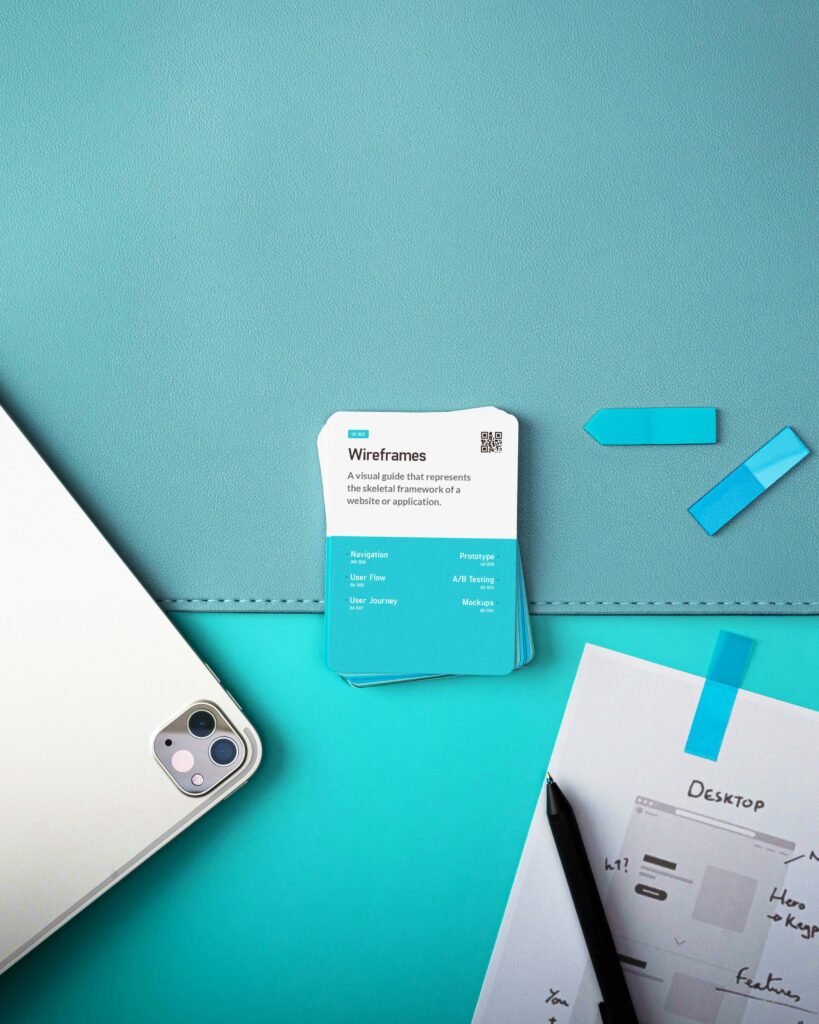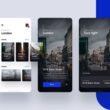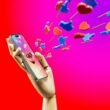User-Centered Design (UCD) is an iterative approach that prioritizes users’ needs, behaviors, and feedback at every stage of the design process. This article explores User-Centered Design basics, showing how designers involve users throughout the process using various research and design techniques to create highly usable and accessible products.
Key Aspects of UCD
- User Research – Understanding user needs through surveys, interviews, and observations.
- Iterative Design – Refining designs based on user feedback.
- Usability Testing – Evaluating effectiveness through real user interactions.
- Accessibility – Ensuring products cater to diverse users, including those with disabilities.
Practical Example
A fintech company designing a mobile banking app conducts user interviews to understand customers’ pain points when managing finances online. The insights from the interviews shape features like simplified navigation, quick-access buttons for frequent transactions, and voice assistance for visually impaired users.
Five-Step Process of UCD
1. Understanding Your Users in UX Design

The first step in creating a great product is understanding the people who will use it. This is called user-centered design (UCD), and it starts with research. Before you design anything, you need to learn about your users—who they are, what they want, and what problems they face. If you skip this step, you might design something that looks good but doesn’t actually help the people it’s meant for.
How Do We Learn About Users?
To truly understand users, UX designers conduct research. This involves:
- Surveys & Questionnaires – Asking people direct questions about their experiences and preferences.
- Interviews & Focus Groups – Talking to real users to understand their needs and challenges.
- Observations – Watching how people use similar products in real-life situations.
Example:
Imagine designing a study app for high school students. Before you start, you’d want to interview students to find out:
- How they currently study
- What distracts them the most
- What features do they wish a study app had
User Personas: Bringing Users to Life
Once you collect research data, the next step is to create user personas. A user persona is a fictional character that represents a typical user of your product. It helps designers understand the goals, habits, and frustrations of real people—a vital step in applying User-Centered Design basics effectively.
Example:
Let’s say you’re making a fitness app for teenagers. One of your personas might be:
- 💡 Name: Alex, 16
- 📍 Habits: Loves sports, uses social media daily, prefers short workout sessions
- 😩 Frustrations: Finds long workouts boring, forgets to track progress
- 🎯 Goal: Wants to stay active but needs motivation
Having a persona like Alex helps designers create features that actually appeal to teenage users, like gamified challenges and progress tracking with rewards.
User Journey Maps: Understanding the Experience
A user journey map helps designers see how a person interacts with a product from start to finish. It also considers how they feel at each step.
Example:
If you’re designing a food delivery app, a user’s journey might look like this:
- Search for food (Excited but unsure what to order)
- Select a restaurant & place an order (Happy, but concerned about wait time)
- Wait for delivery (Impatient or hungry)
- Receive and eat food (Satisfied if the experience was smooth)
If users feel frustrated while ordering, designers might improve the app by adding clearer delivery times or a better search filter.
How Do People Use Your Product?
When thinking about user interactions, designers ask three key questions:
- What device are they using? (A teen might prefer a smartphone over a laptop.)
- Where are they using it? (A study app might be used in a quiet library, while a fitness app is used outdoors.)
- How do they feel while using it? (Are they excited, bored, or frustrated?)
By understanding these details, designers can make products that fit naturally into people’s lives.
2. Defining Goals for Your UX Design

Once you understand who your users are and how they interact with your product, the next step is setting clear goals for both your company and your users. This step is important because it helps ensure that your design is useful for the user while also being successful for the business.
Why Setting Goals is Important
Imagine designing a study app for students. If you don’t set clear goals, you might create an app that looks great but doesn’t actually help students study better. On the other hand, if the company’s goal is to make money, but the app doesn’t attract users, it won’t succeed either. That’s why balancing business needs and user needs is key—one of the fundamental principles of User-Centered Design basics.
Two Types of Goals to Consider
When defining goals, designers think about two important areas:
1. Business Requirements – What the company wants to achieve.
2. User Requirements – What users need to get out of the product.
Business Requirements: What Does the Company Want?
Before creating a product, companies ask themselves these questions:
- What is our expected revenue?
- How much time and resources can we invest?
- What is the scope of the design?
- Who are our key stakeholders?
Example:
Imagine you’re designing an e-commerce website. The company might aim to:
- Increase sales by 20%
- Get more users to sign up for accounts
- Launch the website within 6 months
User Requirements: What Does the User Need?
Designers think about the user’s experience by asking:
- What problem is the design solving?
- What does a successful solution look like?
- What has the user gained from using this product?
Example:
If you’re designing a fitness app for teens, user goals might include:
- A fun way to track workouts
- A motivational system to keep exercising
- A simple design so they don’t feel overwhelmed
How Do You Measure Success?
To know if a product is working, designers track metrics—or key numbers that show progress.
Example:
If you design a language-learning app, you might track:
- 📊 Daily active users
- ⏳ Time spent on lessons
- 🏆 Number of completed courses
If users aren’t reaching their goals, it’s a sign the app needs improvements!
3. Turning Research into Design: Creating Solutions That Work

Now that you understand your users’ needs and your company’s goals, it’s time to start designing!
How Do Designers Create Great Products?
Designers use everything they learned in the research phase to make smart design choices that focus on:
- Making the product easy to use
- Ensuring users enjoy the experience
- Keeping the design aligned with business goals
Key Design Tasks in This Phase
- User Flows – How do users move through the app?
- Information Architecture & Site Maps – Organizing content clearly.
- Choosing Colors, Icons & Images – Creating appealing and useful visuals.
- Wireframing & Prototyping – Drawing and testing rough layouts.
- User Onboarding – Helping new users learn how to use the product.
- UX Copywriting – Writing clear and helpful instructions.
- Accessibility Features – Making the product usable for everyone.
Why It’s Important to Follow User Research
Every design decision should be based on:
- What users need (ease, speed, clarity)
- What the company wants (engagement, growth)
- What fits within the budget and time
4. Testing Your Design: Making Sure It Works

Great! You’ve created a design based on user research and business goals. Now it’s time to test your product to see if it actually solves the problem.
Why Is Testing Important?
Usability testing helps you:
- Find problems early before launching
- Make sure users understand and enjoy the design
- Improve the product so it meets both user and business goals
Key Questions to Ask During Testing
- How do users respond to the product?
- What is working well? What isn’t?
- Did the product solve the user’s problem?
- What can be improved? How?
- Are company goals met? Why or why not?
How Do You Conduct Usability Testing?
- User Testing Sessions
- Surveys & Feedback Forms
- A/B Testing
- Eye Tracking & Heatmaps
Pay Attention to User Reactions
- If a user hesitates before clicking, the button might be unclear.
- If they look frustrated, the process might be too complicated.
- If they smile or react positively, that’s a sign of a great experience!
It’s Okay to Make Mistakes!
The key is to keep learning, improving, and listening to users.
5. Improving Your Design: The Cycle Never Ends!

Why Do We Keep Improving the Design?
- To fix what didn’t work
- To make the product better
- To keep up with user needs
How to Use Feedback to Improve
- What worked well? Keep those features!
- What didn’t work? Fix them!
- What should we add? New ideas?
Iteration: The Secret to a Great Product
🔄 Iteration means repeating the design process over and over again to make small, meaningful improvements.
Even After Launch, Keep Evaluating!
- Keep collecting feedback
- Analyze user interactions
- Make small updates
Takeaway
Design is never “done”—it’s a cycle of learning, improving, and growing. By applying User-Centered Design basics, listening to your users, and refining your work, you’ll create products that truly meet their needs and make a difference!










